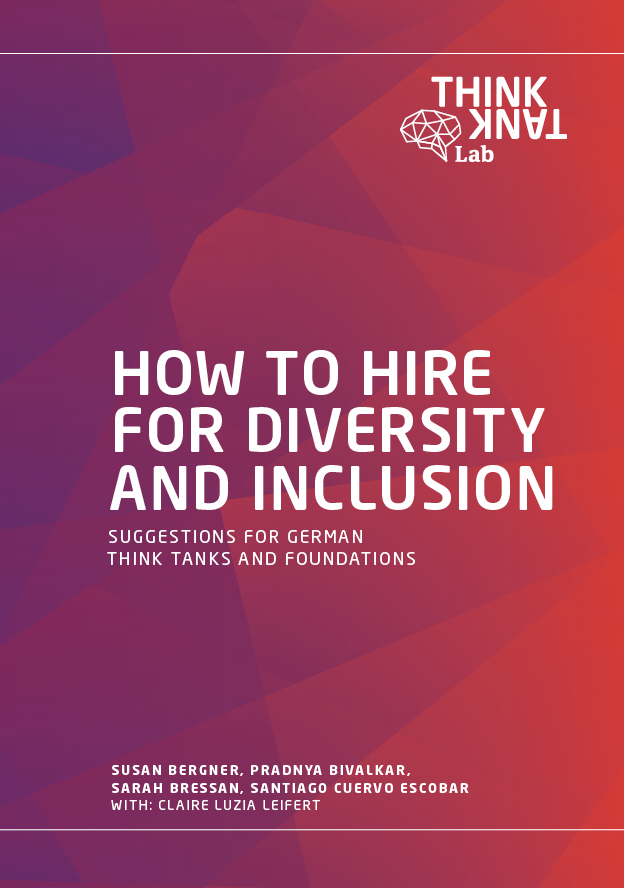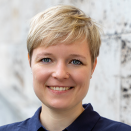Foreword
This guide aims to provide suggestions and inspiration for more inclusive hiring practices in think tanks and foundations based on a qualitative lived-experiences approach. While diversity encompasses various dimensions and nuances, we focus in this text on young research professionals with migratory backgrounds as the main target group. However, some suggestions might be adaptable to different contexts or other groups. Our recommendations are directed at think tanks and foundations that want to become more inclusive workplaces. This guide covers the job posting process, candidate screening, interviewing, and the onboarding phase. Our propositions for enhancing inclusive hiring efforts are grounded in the lived experiences of the authors and on interviews with research professionals working in think tanks and foundations in Germany, some of whom have faced hurdles linked to their background or are engaged in creating diversity policies and designing hiring processes. With this guide we want to contribute to the broader discussion of diversity and inclusion in research institutes and foundations. We hope to stimulate further exchanges and help ensure ongoing diversity policies are grounded in lived experiences.
This online text is the introduction to and summary of our Hiring Guide. Download the full guide here.
Content of the Guide
- Introduction
- Methodology
- Recommendations
- 1. Make Job Postings more Inclusive
- 2. Remove Biases in Candidate Screening
- 3. Conduct More Inclusive Job Interviews
- 4. Make Onboarding More Inclusive
- Communications
- Conclusion
- Three Tips For Young Professionals With Migration Background
Introduction
Looking at many German think tank or foundation’s websites, it is clear that our organizations fail to reflect the diversity of our society, let alone the societies we work with, research, and advise on. The apparent lack of diversity in think tanks and foundations raises questions about how our relative demographic homogeneity influences our perspectives on contemporary socio-political issues.
Many think tank and foundation leaders are becoming increasingly aware of the benefits of diversity and inclusion due to mounting evidence that more diverse workplaces have higher employee satisfaction and better-quality output. Having a greater diversity of staff across all levels of the organization also brings greater diversity of thought in policy research and in how think tanks operate. Since think tanks and foundations engaged in international affairs work with, write about, and advise on people and politics in other countries, bringing in diversity of thought, cultural background, and life experience through inclusive hiring practices should be an organizational priority to make sure our research and policy advice is high quality, contextual, and relevant.
The goal of this guide is to provide organizations with ideas about how to remove barriers in the hiring process for entry-level positions and contribute to a sense of belonging for people with diverse backgrounds who do not belong to the organization’s demographic majority.
Some of the key questions we address in this guide include:
- How might we make the hiring process more inclusive, with a special focus on entry-level professionals with migratory backgrounds?
- How might we make job advertisements attractive for people with migratory backgrounds and encourage them to apply?
- How might we implement and communicate inclusive practices in the job screening, interview, and onboarding process?
- What strategies might help professionals with migratory backgrounds?
- How might we make sustainable policy changes in the organization to ensure it is hiring for diversity in the long-term?
Methodology
These recommendations are informed by an analysis that took place throughout the Think Tank Lab Diversity Challenge between September 2021 and January 2022. As part of the working group, participants discussed the state of diversity, equity and inclusion (DEI) in the German think tank and foundations sector and developed practical solutions to foster DEI in our organizations.
The working group consisted of eight practitioners (two men and five women) working in German think tanks and foundations – some of them with a migratory background. Our analysis is based on the lived experiences of the authors, existing research on the topic, and stakeholder interviews with people affected by or working on diversity matters and hiring practices in German think tanks and foundations.
You can find more information on the make-up of this group and the methodology used here. The guide was developed to help address the obstacles professionals with migratory backgrounds and other non-majority backgrounds face when entering the think tank and foundations sector. It puts the burden of change on organizations and not candidates.
Because entry-level positions are a key talent pipeline for think tanks and foundations, we have focused on providing recommendations how to attract and retain young researchers with a greater diversity of ethnicities and countries of origin. By doing so, we intend to help organizations achieve diversity goals along the vectors of ethnicity, countries of origin, and young age. This choice was made while being fully aware that diversity is a vast topic and involves other equally important characteristics like gender, sexual orientation and identities, physical (dis)abilities and neurodivergence, which in reality all intersect. This guide also focuses on entry-level hiring processes because we were able to collect evidence and experiences from our own careers and throughout the interview phase of the Diversity Challenge. We understand that there is a broad diversity of profiles, experiences, and biographies, even within this selected group. This is why we do not aim for these suggestions to work on a “one size fits all” basis, but rather to give organizations practical strategies that can be implemented in their efforts towards more equality and inclusion. We hope that these practical strategies will ease the obstacles and challenges that professionals with migratory backgrounds – in all their diversity – tend to face when entering the think tank and foundation sector.
While this guide primarily addresses the needs and experiences of research and project management staff, we are aware that other types of personnel including IT, communications, human resources (HR), or event management are equally important for organizations and should also benefit from inclusive recruiting and onboarding practices.
Recommendations
The recruitment process is an essential building block for creating more inclusive practices in German think tanks and foundations. Different stages of the recruiting process can be made more inclusive, starting with the phrasing and criteria in job postings, candidate screening practices, how job interviews are conducted, and which onboarding strategies are implemented.
This guide includes recommendations for how each of these four stages can be made more inclusive. This non-exhaustive list should feed into a more inclusive everyday organizational culture.
To give feedback on this guide please write to: thinktanklab@dgap.org
Download the full guide with the recommendations here.




